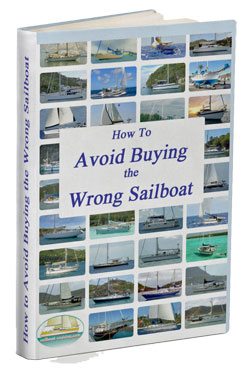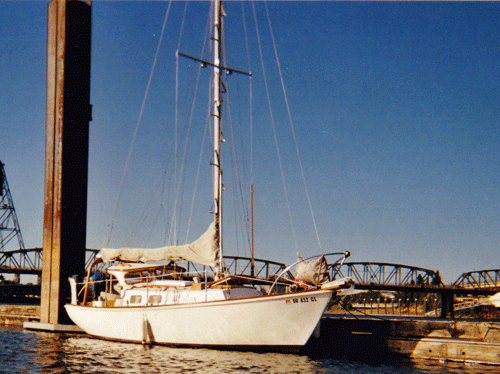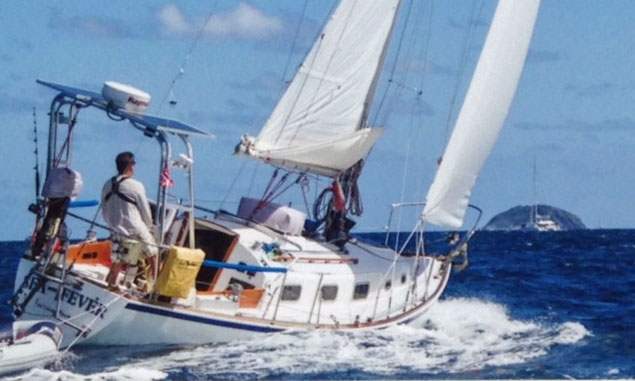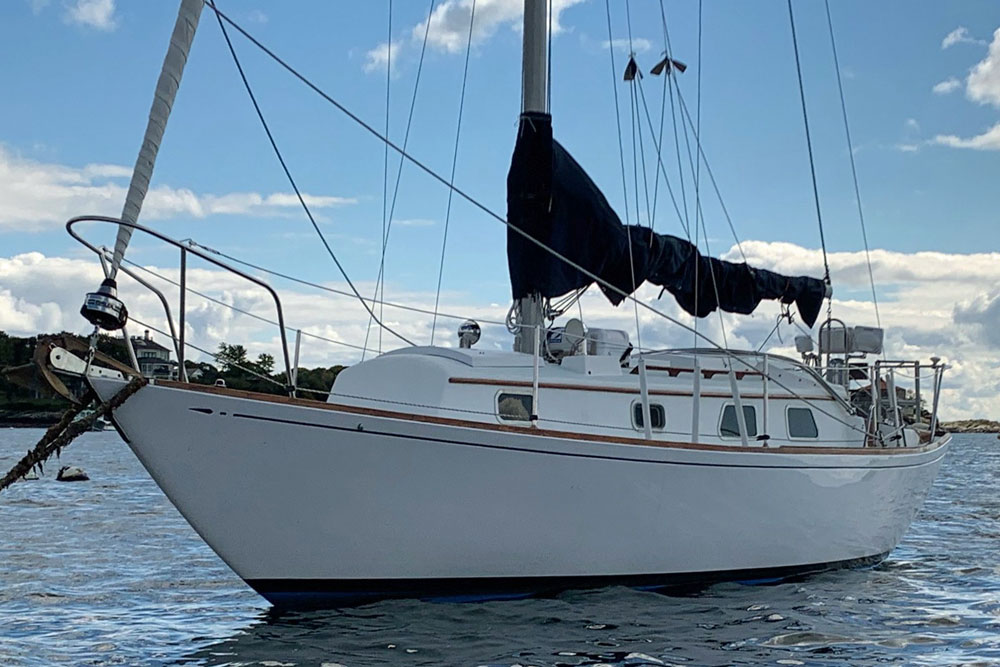- Home
- Cruising Yachts 40' to 45'
- Bristol 40
The Bristol 40 Sailboat
Specs & Key Performance Indicators
The Bristol 40, a masthead sloop, was designed by Ted Hood and built in the USA by Bristol Yachts.
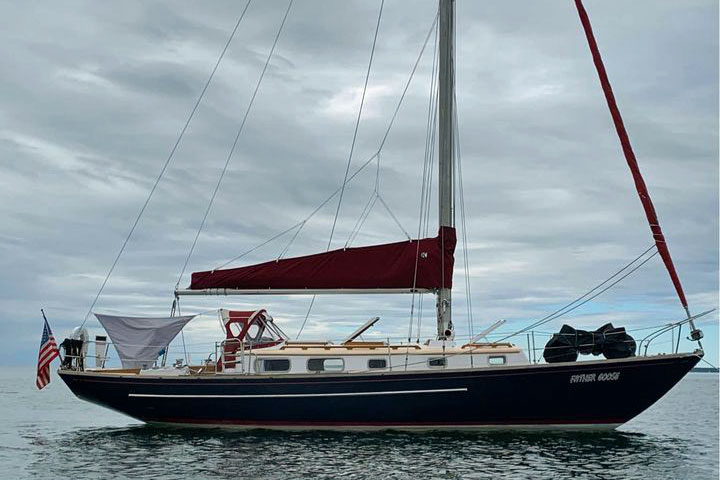 A Bristol 40 Sloop
A Bristol 40 SloopPublished Specification for the Bristol 40
Underwater Profile: Long keel
Hull Material: GRP (Fibreglass)
Length Overall: 40'2" (12.2m)
Waterline Length: 27'6" (8.4m)
Beam: 10'9" (3.3m)
Draft: 5'4" (1.6m)
Rig Type: Masthead sloop (also available as a yawl or cutter)
Displacement: 17,580lb (7,974kg)
Ballast: 6,500lb (2,948kg)
Designer: Ted Hood
Builder: Bristol Yachts (USA)
Year First Built: 1970
Year Last Built: 1986
Number Built: 149
Published Design Ratios for the Bristol 40
1. Sail Area/Displacement Ratio: 16.5
2. Ballast/Displacement Ratio: 37.0
3. Displacement/Length Ratio: 376
4. Comfort Ratio: 36.7
5. Capsize Screening Formula: 1.7
Summary Analysis of the Design Ratios for the Bristol 40
1. A Sail Area/Displacement Ratio of 16.5 suggests that the Bristol 40 will, in the right conditions, approach her maximum hull speed readily and satisfy the sailing performance expectations of most cruising sailors.
2. A Ballast/Displacement Ratio of 37.0 means that a sailboat like the Bristol 40, is likely to benefit from being reefed early to keep her sailing upright in a moderate breeze.
3. A Displacement/Length Ratio of 376 tells us the Bristol 40 is firmly in the ultra-heavy displacement category. Load her up as much as you like and her performance will be hardly affected, not that it was ever startling. Few if any sailboats are built to this displacement category these days - but they remain popular with some long-distance sailors.
4. Ted Brewer's Comfort Ratio of 36.7 suggests that crew comfort of a Bristol 40 in a seaway is similar to what you would associate with the motion of a moderate bluewater cruising boat - a predictable and acceptable motion for most seasoned sailors.
5. The Capsize Screening Formula (CSF) of 1.7 indicates that a Bristol 40 would be a safer choice of sailboat for an ocean passage than one with a CSF of more than 2.0.
More about the Bristol 40 sailboat...
The Bristol 40 is a classic American sailboat that was designed by Ted Hood as a racer-cruiser and first built in 1970. It is a beautiful and elegant boat with traditional lines, long overhangs, a lovely sheerline, a low freeboard and a narrow cabin trunk.
The boat has a masthead sloop rig, with an optional cutter or yawl rig, and a modified long keel with a cutaway forefoot and a keel-mounted rudder.
The boat is well-built and solid, with a fiberglass hull and deck and wood trim. The boat is suitable for coastal cruising and offshore passages, as well as club racing. The boat has a loyal following of owners and admirers who appreciate its timeless style and sailing qualities.
Accommodation
The Bristol 40 has a spacious and comfortable interior for a boat of its era, with sleeping accommodation for six people.
The layout consists of a double V-berth in the forward cabin, an U-shaped settee and dinette table on the port side of the main cabin that converts to a double berth, a straight settee on the starboard side with a pipe berth above it, and a quarter berth aft of the navigation station on the starboard side.
The boat has one head compartment with a marine toilet and a sink, located on the port side between the forward cabin and the main cabin.
The galley is located on the port side near the companionway, and is equipped with a three-burner alcohol stove, an oven, a sink, and ample storage space. The navigation station is opposite the galley on the starboard side, and has a large chart table and an instrument panel.
The boat has plenty of natural light and ventilation from several opening ports and hatches. The interior is finished in warm teak woodwork and has a traditional charm.
Hull and Deck
The Bristol 40 has a fiberglass hull and deck that are strong and durable. The hull is molded in one piece with no core material, while the deck is cored with balsa wood for stiffness and insulation.
The boat has a raised counter reverse transom that provides more buoyancy and space for the rudder. The boat has a spooned raked stem that gives it a graceful profile. The boat has an Edson wheel steering system that is mounted on a pedestal in the spacious and comfortable aft cockpit.
Mast and Rigging
The Bristol 40 has a masthead sloop rig, with an optional cutter or yawl rig. The mast and boom are made of aluminum and are painted white. The mast is keel-stepped and has two sets of spreaders. The mast has internal halyards for the main, jib, and spinnaker.
Keel and Rudder
The Bristol 40 has a modified long keel that provides stability and directional control. The keel has a cutaway forefoot that reduces wetted surface and improves maneuverability. The keel is made of fiberglass and encapsulates 6,500 lb (2,948 kg) of lead ballast. The keel has a draft of 5.40 ft (1.65 m) with the standard configuration, but a stub keel and centerboard version was also available.
The Bristol 40 has a keel-mounted rudder that is controlled by an Edson wheel steering system.
The rudder is made of fiberglass and has a stainless steel stock and fittings. The rudder has a balanced design that reduces the steering effort and improves the responsiveness. The rudder is protected by a bronze shoe at the bottom of the keel.
Versions and Options
The Bristol 40 was produced from 1970 to 1986, with a total of 149 units built. The boat was based on the earlier Bristol 39, which was produced from 1966 to 1970, with 58 units built. The Bristol 39 and 40 are nearly identical in their principle dimensions, but have different lengths overall due to some changes in the hull sections aft and the stemhead fitting. The Bristol 40 was available in different versions and options, such as:
- Keel or keel/centerboard configuration: The standard version had a fixed modified long keel with a draft of 5.40 ft (1.65 m), while the optional version had a stub keel and a centerboard with a draft of 7.8 ft (2.4 m) when extended and 4.0 ft (1.2 m) when retracted. The centerboard was made of fiberglass and was operated by a pennant line that led to the cockpit.
- Masthead sloop, cutter or yawl rig: The standard version had a masthead sloop rig with a single forestay and a single mainsail, while the optional versions had either a cutter rig with an inner forestay and an inner jib or staysail, or a yawl rig with a mizzen mast and sail aft of the rudder post.
- Gasoline or diesel engine: The standard version had a Universal Atomic 4 30 hp (22 kW) gasoline engine, while the optional version had a Westerbeke diesel engine.
This article was written with the assistance of Gemini, a large language model developed by Google. Gemini was used to gather information, summarize research findings, and provide suggestions for the content and structure of the article.
Other sailboats in the Bristol range include:
Recent Articles
-
Albin Ballad Sailboat: Specs, Design, & Sailing Characteristics
Jul 09, 25 05:03 PM
Explore the Albin Ballad 30: detailed specs, design, sailing characteristics, and why this Swedish classic is a popular cruiser-racer. -
The Hinckley 48 Sailboat
Jul 09, 25 02:44 PM
Sailing characteristics & performance predictions, pics, specifications, dimensions and those all-important design ratios for the Hinckley 48 sailboat... -
The Hinckley Souwester 42 Sailboat
Jul 09, 25 02:05 PM
Sailing characteristics and performance predictions, pics, specifications, dimensions and those all-important design ratios for the Hinckley Souwester 42 sailboat...
